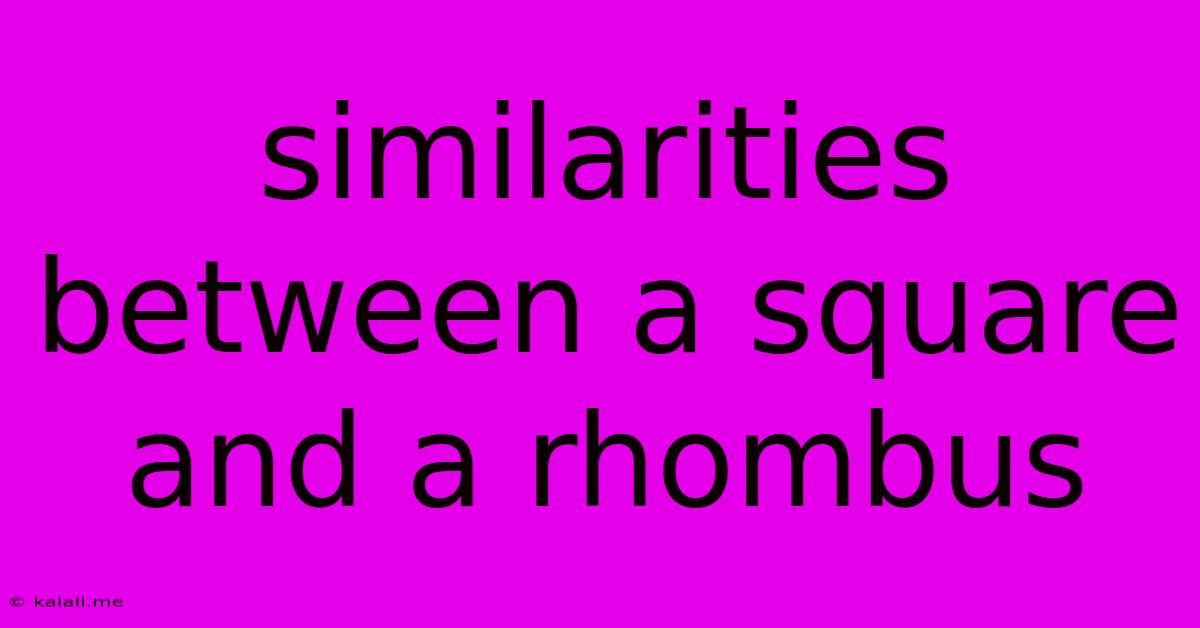Similarities Between A Square And A Rhombus
Kalali
Jun 15, 2025 · 2 min read

Table of Contents
Unveiling the Shared Traits: Squares and Rhombuses
Squares and rhombuses, both fascinating shapes in the world of geometry, often get confused due to their striking similarities. While distinct in certain aspects, understanding their shared characteristics provides a deeper appreciation for their geometric properties. This article delves into the key similarities between squares and rhombuses, helping you differentiate them while appreciating their common ground. This will be particularly helpful for students studying geometry, as well as anyone interested in understanding the fundamental properties of quadrilaterals.
Key Similarities Between Squares and Rhombuses:
Both squares and rhombuses belong to the broader family of quadrilaterals – four-sided polygons. Their similarities extend beyond this basic classification. Let's explore the key shared characteristics:
-
Four Sides: The most fundamental similarity is that both shapes possess four sides. This is the defining feature of all quadrilaterals, including squares and rhombuses.
-
Equal Side Lengths: This is perhaps the most significant similarity. All four sides of both a square and a rhombus are equal in length. This property distinguishes them from other quadrilaterals like rectangles or parallelograms, where sides can have varying lengths. This equal side length property is crucial in understanding their areas and perimeters. Calculating the perimeter is straightforward; simply multiply the length of one side by four.
-
Opposite Sides are Parallel: Both shapes exhibit parallelism in their opposite sides. This means that if you extend the lines of opposite sides, they will never intersect. This property places them within the category of parallelograms. This parallelism influences their stability and symmetry.
-
Opposite Angles are Equal: Another important shared characteristic is the equality of opposite angles. In both shapes, the angles opposite each other are congruent; they have the same measure. This symmetrical distribution of angles contributes to the overall balanced structure of both shapes.
Where they Differ:
While sharing many features, squares and rhombuses diverge in one crucial aspect: angle measure.
-
Squares: Possess four right angles (90 degrees each). This makes them a special type of rhombus with additional properties.
-
Rhombuses: Can have any angle measure, as long as opposite angles are equal. This means a rhombus doesn't necessarily have to be a square. It could have acute angles, obtuse angles, or a mix of both, as long as opposite angles match.
Conclusion:
In summary, squares and rhombuses share the crucial properties of having four equal sides, parallel opposite sides, and equal opposite angles. However, the defining difference lies in their angles; squares always have right angles, while rhombuses can have any angle measurement as long as opposite angles are equal. Understanding these similarities and differences solidifies your grasp of fundamental geometric concepts and empowers you to easily distinguish between these shapes. By recognizing these shared attributes, you'll strengthen your understanding of quadrilateral geometry and develop more advanced geometrical intuition.
Latest Posts
Latest Posts
-
What Is The Lcm Of 6 And 24
Jun 15, 2025
-
The Number Of Cycles Per Second Is Called
Jun 15, 2025
-
The Blank Defended The Benefits Of Economic Development
Jun 15, 2025
-
How Many Players On Volleyball Court
Jun 15, 2025
-
Do Satellites Use Radio Waves Or Microwaves
Jun 15, 2025
Related Post
Thank you for visiting our website which covers about Similarities Between A Square And A Rhombus . We hope the information provided has been useful to you. Feel free to contact us if you have any questions or need further assistance. See you next time and don't miss to bookmark.